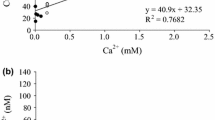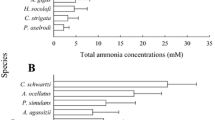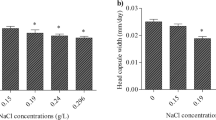Abstract
While it has been well established that increasing chloride concentration in water reduces the toxicity of nitrite to freshwater species, little work has been done to investigate the effect of chloride on nitrate toxicity. We conducted acute and chronic nitrate (as sodium nitrate) toxicity tests with the cladoceran Ceriodaphnia dubia and the amphipod Hyalella azteca (chronic tests only) over a range of chloride concentrations spanning natural chloride levels found in surface waters representative of watersheds of the Great Lakes Region. Chronic nitrate toxicity test results with both crustaceans were variable, with H. azteca appearing to be one of the more sensitive invertebrate species tested and C. dubia being less sensitive. While the variability in results for H. azteca were to an extent related to chloride concentration in test water that was distinctly not the case for C. dubia. We concluded that the chloride dependent toxicity of nitrate is not universal among freshwater crustaceans. An additional sodium chloride chronic toxicity test with the US Lab strain of H. azteca in the present study suggested that when present as predominantly sodium chloride and with relatively low concentrations of other ions, there is a narrow range of chloride concentrations over which this strain is most fit, and within which toxicity test data are reliable.


Similar content being viewed by others
References
Alcaraz G, Espina S (1994) Effect of nitrite on the survival of grass carp, Ctenopharyngodon idelia (Val.), with relation to chloride. Bull Environ Contam Toxicol 52:74–79
Alonso A, Camargo JA (2008) Ameliorating effect of chloride on nitrite toxicity to freshwater invertebrates with different physiology: a comparative study between amphipods and planarians. Arch Environ Contam Toxicol 54:259–265
American Public Health Association (2005) Standard methods for the examination of water and wastewater, 21st edn. APHA-AWWAWPCF, Washington, DC
ASTM (2002a) Standard guide for conducting acute toxicity testing on test materials with fishes, macroinvertebrates, and amphibians. Designation: E729-96. American Society for Testing and Materials, West Conshohocken, PA
ASTM (2002b) Standard guide for conducting three-brood, renewal toxicity tests with Ceriodaphnia dubia. Designation: E1295-01. American Society for Testing and Materials, West Conshohocken
Bartlett F, Neumann D (1998) Sensitivity of brown trout alevins (Salmo trutta L.) to nitrite at different chloride concentrations. Bull Environ Contam Toxicol 60:340–346
Bartlett AJ, Rochfort Q, Brown LR, Marsalek J (2012) Causes of toxicity to Hyalella azteca in a stormwater management facility receiving highway runoff and snowmelt. Part II: salts, nutrients, and water quality. Sci Tot Environ 414:238–247
Beitinger TL, Huey DW (1981) Acute toxicity of nitrite to crayfish Procambarus simulans in varied environmental conditions. Environ Pollut 26:305–311
Benbow ME, Merritt RW (2004) Road-salt toxicity of selected Michigan wetland macroinvertebrates under different testing conditions. Wetlands 24:68–76
Camargo JA (2004) Effects of body size and sodium chloride on the tolerance of net-spinning caddisfly larvae to fluoride toxicity. Bull Environ Contam Toxicol 72:579–585
Camargo JA, Alonso A (2006) Ecological and toxicological effects of inorganic nitrogen pollution in aquatic ecosystems: a global assessment. Environ Int 32:831–849
Camargo JA, Ward JV (1992) Short-term toxicity of sodium nitrate (NaNO3) to non-target freshwater invertebrates. Chemosphere 24:23–28
Camargo JA, Alonso A, Salamanca A (2005) Nitrate toxicity to aquatic animals: a review with new data for freshwater invertebrates. Chemosphere 58:1255–1267
Cheng SY, Chen JC (1998) Effects of nitrite exposure on the hemolymph electrolyte, respiratory protein and free amino acid levels and water content of Penaeus japonicus. Aquat Toxicol 44:129–139
Cheng S-Y, Chen J-C (2002) Study on the oxyhemocyanin, deoxyhemocyanin, oxygen affinity and acid–base balance of Marsupenaeus japonicas following exposure to combined elevated nitrite and nitrate. Aquatic Toxicol 61:181–193
Corrao NM, Darby PC, Pomory CM (2006) Nitrate impacts on the Florida apple snail, Pomacea paludosa. Hydrobiologia 568:135–143
Duan Y, Guttman SI, Oris JT (1997) Genetic differentiation among laboratory populations of Hyalella azteca: implications for toxicology. Environ Toxicol Chem 16:691–695
Elphick JRF, Bergh KD, Bailey HC (2011) Chronic toxicity of chloride to freshwater species: effects of hardness and implications for water quality guidelines. Environ Toxicol Chem 30:239–246
Gutzmer MP, Tmoasso JR (1985) Nitrite toxicity to the crayfish Procambarus clarkii. Bull Environ Contam Toxicol 34:369–376
Hamilton MA, Russo RC, Thurston RV (1977) Trimmed Spearman-Karber method for estimating lethal concentrations in toxicity bioassays. Environ Sci Technol 1:714–719
Harris RR, Coley S (1991) The effects of nitrite on chloride regulation in the crayfish Pacifastacus leniusculus Dana (Crustacea: decapoda). J Comp Physiol B 161:199–206
Hogg ID, Larose C, de Lafontaine Y, Doe KG (1998) Genetic evidence for a Hyalella species complex within the Great Lakes—St. Lawrence River drainage basin: implications for ecotoxicology and conservation biology. Can J Zool 76:1134–1140
Ingersoll CG, Dwyer JF, Burch SA, Nelson MK, buckler DR, Hunn JB (1992) The use of freshwater and saltwater animals to distinguish between the toxic effects of salinity and contaminants in irrigation drain water. Environ Toxicol Chem 11:503–511
Ivey CD, Ingersoll CG (2016) Influence of bromide on the performance of the amphipod Hyalella azteca in reconstituted waters. Environ Toxicol Chem. doi:10.1002/etc.3421
Ivey CD, Ingersoll CG, Brumbaugh WG, Hammer EJ, Mount DR, Hockett JR, Norberg-King TJ, Soucek DJ, Taylor L (2016) Using an inter-laboratory study to revise methods for conducting 10- to 42-d water or sediment toxicity tests with Hyalella azteca. Environ Toxicol Chem. doi:10.1002/etc.3417
Jensen FB (1996) Uptake, elimination and effects of nitrite and nitrate in freshwater crayfish (Astacus astacus). Aquat Toxicol 34:95–104
Kozák P, Máchová J, Policar T (2005) The effect of chloride content in water on the toxicity of sodium nitrite for spiny-cheek crayfish (Orconectes limosus Raf.). Bull Fr Pêche Piscic 376–377:705–714
Lewis WM Jr, Morris DP (1986) Toxicity of nitrite to fish: a review. Trans Am Fish Soc 115:183–195
Major KM, Soucek DJ, Giordano R, Wetzel MJ, Soto-Adames F (2013) The common ecotoxicology laboratory strain of Hyalella azteca is genetically distinct from most wild strains sampled in eastern North America. Environ Toxicol Chem 32:2637–2647
Martin ML, Thompson KA (2012) Chronic sensitivity of two native New Zealand species (freshwater fish—Inanga Galaxias maculatus and mayfly—Deleatidium sp.) to nitrate. HBR12230. NIWA report for Hawke’s Bay Regional Council, Hamilton
McGurk MD, Landry F, Tang A, Hanks CC (2006) Acute and chronic toxicity of nitrate to early life stages of lake trout (Salvelinus namaycush) and lake whitefish (Coregonus clupeaformis). Environ Toxicol Chem 25:2187–2196
McPeek MA, Wellborn GA (1998) Genetic variation and reproductive isolation among phenotypically divergent amphipod populations. Limnol Oceanogr 43:1162–1169
Mount DR, Gulley JM, Hockett JR, Garrison TD, Evans JM (1997) Statistical models to predict the toxicity of major ions to Ceriodaphnia dubia, Daphnia magna, and fathead minnows (Pimephales promelas). Environ Toxicol Chem 16:2009–2019
Neumann D, Kramer M, Raschke I, Gräfe B (2001) Detrimental effects of nitrite on the development of benthic Chironomus larvae in relation to their settlement in muddy sediments. Arch Hydrobiol 153:103–128
Schuytema GS, Nebeker AV (1999) Effects of ammonium nitrate, sodium nitrate, and urea on red-legged frogs, Pacific treefrogs, and African clawed frogs. Bull Environ Contam Toxicol 63:357–364
Scott G, Crunkilton RL (2000) Acute and chronic toxicity of nitrate to fathead minnows (Pimephales promelas), Ceriodaphnia dubia, and Daphnia magna. Environ Toxicol Chem 19:2918–2922
Soucek DJ (2007) Comparison of hardness and chloride-regulated acute effects of sodium sulfate on two freshwater crustaceans. Environ Toxicol Chem 26:773–779
Soucek DJ, Dickinson A (2012) Acute toxicity of nitrate and nitrite to sensitive freshwater insects, mollusks, and a crustacean. Arch Environ Contam Toxicol 62:233–242
Soucek DJ, Dickinson A (2015) Full-life chronic toxicity of sodium salts to the mayfly Neocloeon triangulifer in tests with laboratory cultured food. Environ Toxicol Chem 34:2126–2137
Soucek DJ, Dickinson A, Major KM, McEwen AR (2013) Effect of test duration and feeding on relative sensitivity of genetically distinct clades of Hyalella azteca. Ecotoxicology 22:1359–1366
Soucek DJ, Mount DR, Dickinson A, Hockett JR, McEwen AR (2015) Contrasting effects of chloride on growth, reproduction, and toxicant sensitivity in two genetically distinct strains of Hyalella azteca. Environ Toxicol Chem 34:2354–2362
Stanley EH, Maxted JT (2008) Changes in the dissolved nitrogen pool across land cover gradients in Wisconsin streams. Ecol Appl 18:1579–1590
Stelzer RS, Joachim BL (2010) Effects of elevated nitrate concentration on mortality, growth, and egestion rates of Gammarus pseudolimnaeus amphipods. Arch Environ Contam Toxicol 58:694–699
Tomasso JR (1986) Comparative toxicity of nitrite to freshwater fishes. Aquat Toxicol 8:129–137
Tomasso JR, Carmichael GJ, Fuller SA (2003) Nitrite toxicity to the razorback sucker, Xyrauchen texanus, and the bonytail, Gila elegans: inhibition by environmental chloride. J Appl Aquacult 14:179–183
Tsai SJ, Chen JC (2002) Acute toxicity of nitrate on Penaeus monodon juveniles at different salinity levels. Aquaculture 213:163–170
USEPA (2000) Methods for measuring the toxicity and bioaccumulation of sediment-associated contaminants with freshwater invertebrates, 2nd edn. EPA-600-R-99-064. US Environmental Protection Agency, Washington, DC
USEPA (2002) Short-term methods for estimating the chronic toxicity of effluents and receiving waters to freshwater organisms, 4th edn. EPA-821-R-02-013. US Environmental Protection Agency, Washington, DC
USEPA (2010) Final report on acute and chronic toxicity of nitrate, nitrite, boron, manganese, fluoride, chloride and sulfate to several aquatic animal species. EPA 905-R-10-002. US Environmental Protection Agency, region 5, Chicago, IL
Werner I, Deanovic LA, Markiewicz D, Khamphanh M, Reece CK, Stillway M, Reece C (2010) Monitoring acute and chronic water column toxicity in the northern Sacramento-San Joaquin estuary, California, USA, using the euryhaline amphipod, Hyalella azteca: 2006 to 2007. Environ Toxicol Chem 29:2190–2199
Acknowledgments
This study was funded by the Great Lakes Restoration Initiative by way of a Cooperative Ecosystem Studies Unit Grant (#G12AC20285) from the US Geological Survey, Columbia Environmental Research Center. M. Hung (University of Illinois) assisted with experiments.
Author information
Authors and Affiliations
Corresponding author
Ethics declarations
Conflict of interest
The authors declare that they have no conflict of interest.
Electronic supplementary material
Below is the link to the electronic supplementary material.
Rights and permissions
About this article
Cite this article
Soucek, D.J., Dickinson, A. Influence of chloride on the chronic toxicity of sodium nitrate to Ceriodaphnia dubia and Hyalella azteca . Ecotoxicology 25, 1406–1416 (2016). https://doi.org/10.1007/s10646-016-1691-1
Accepted:
Published:
Issue Date:
DOI: https://doi.org/10.1007/s10646-016-1691-1




